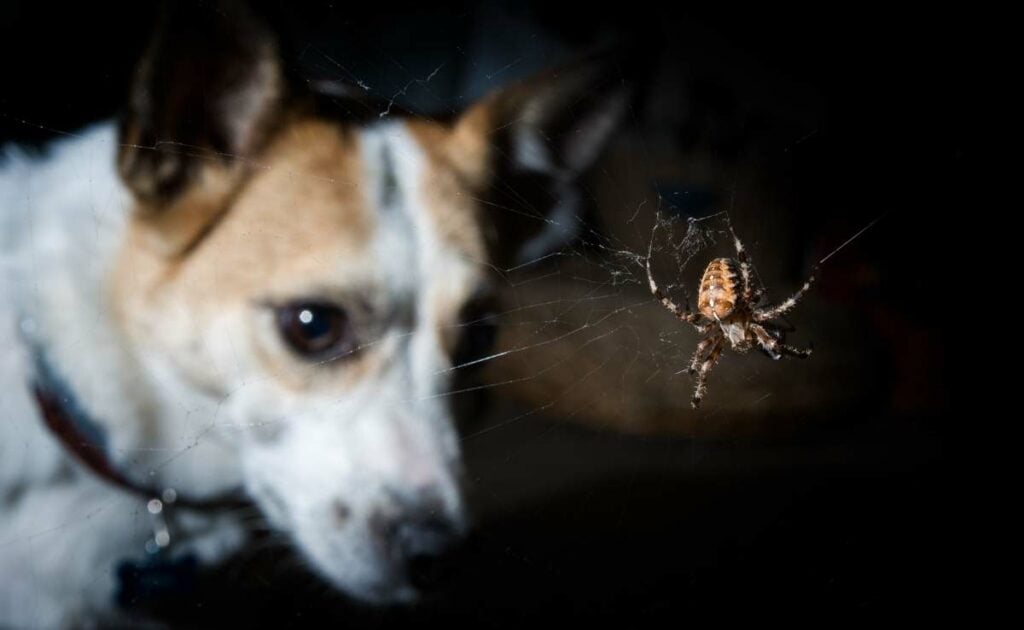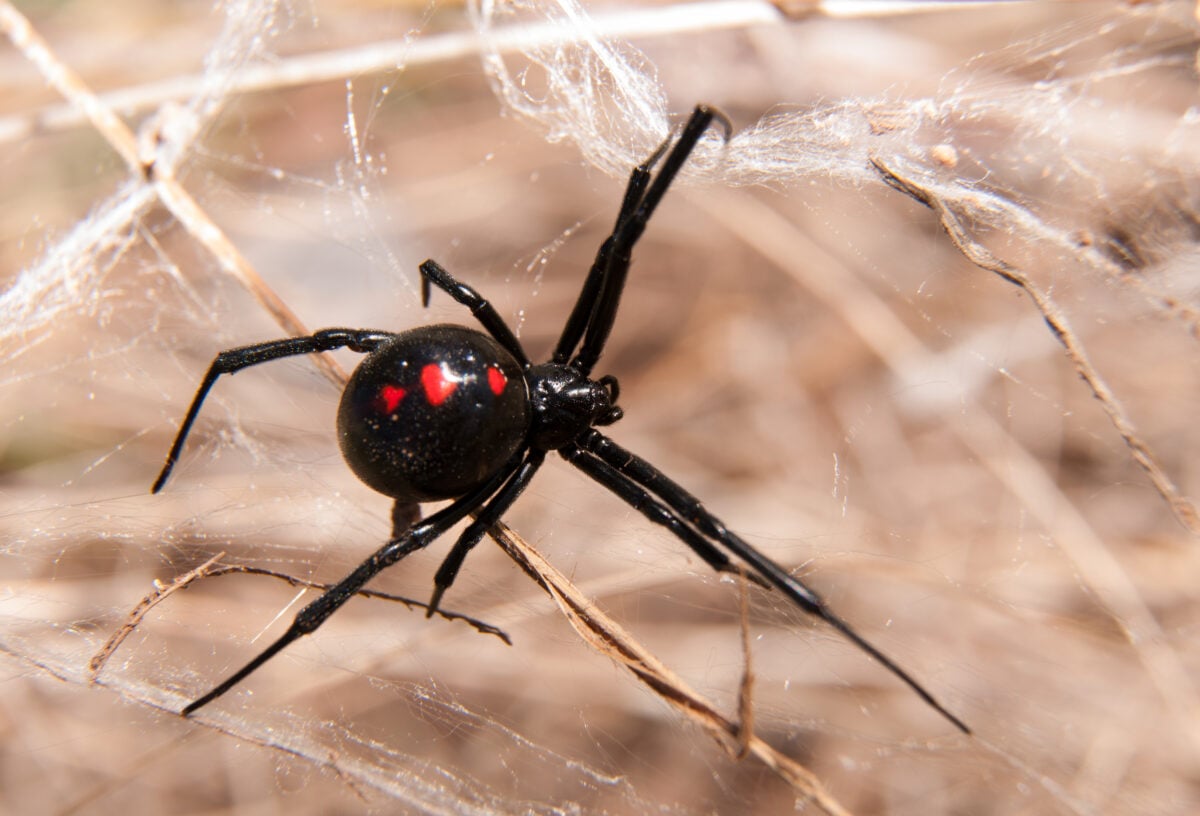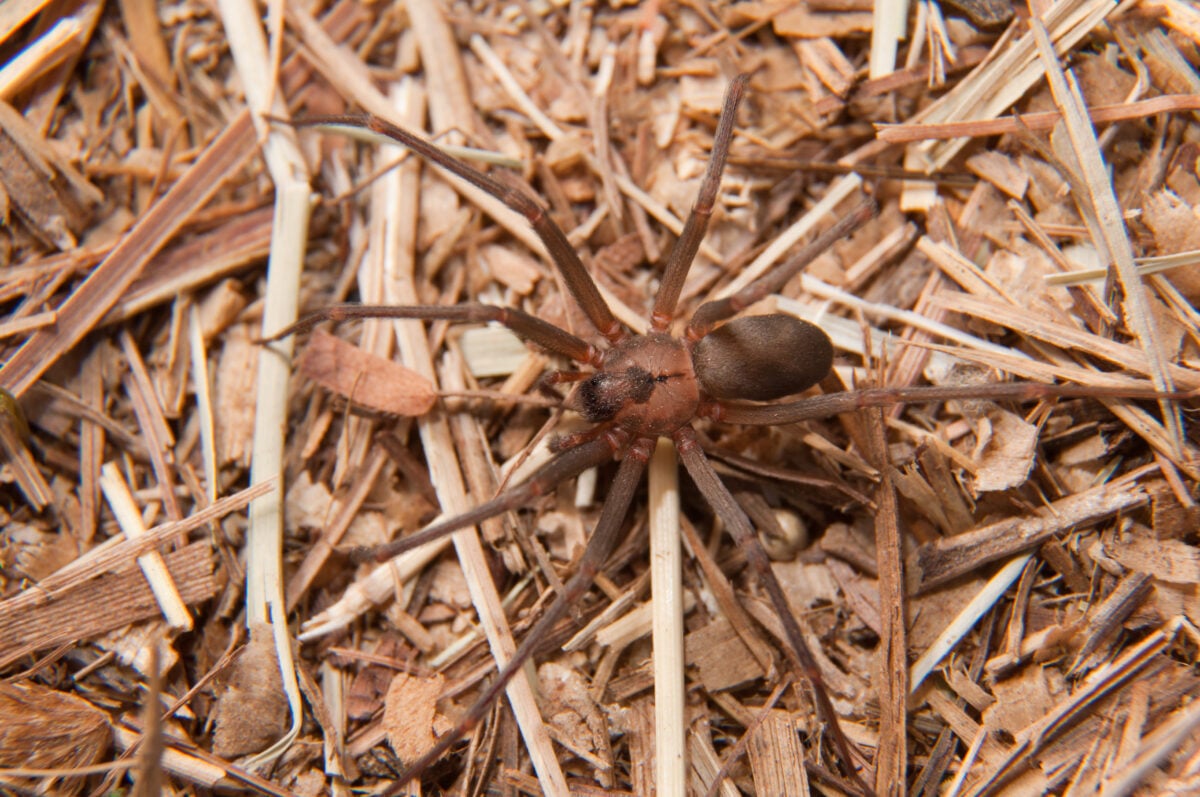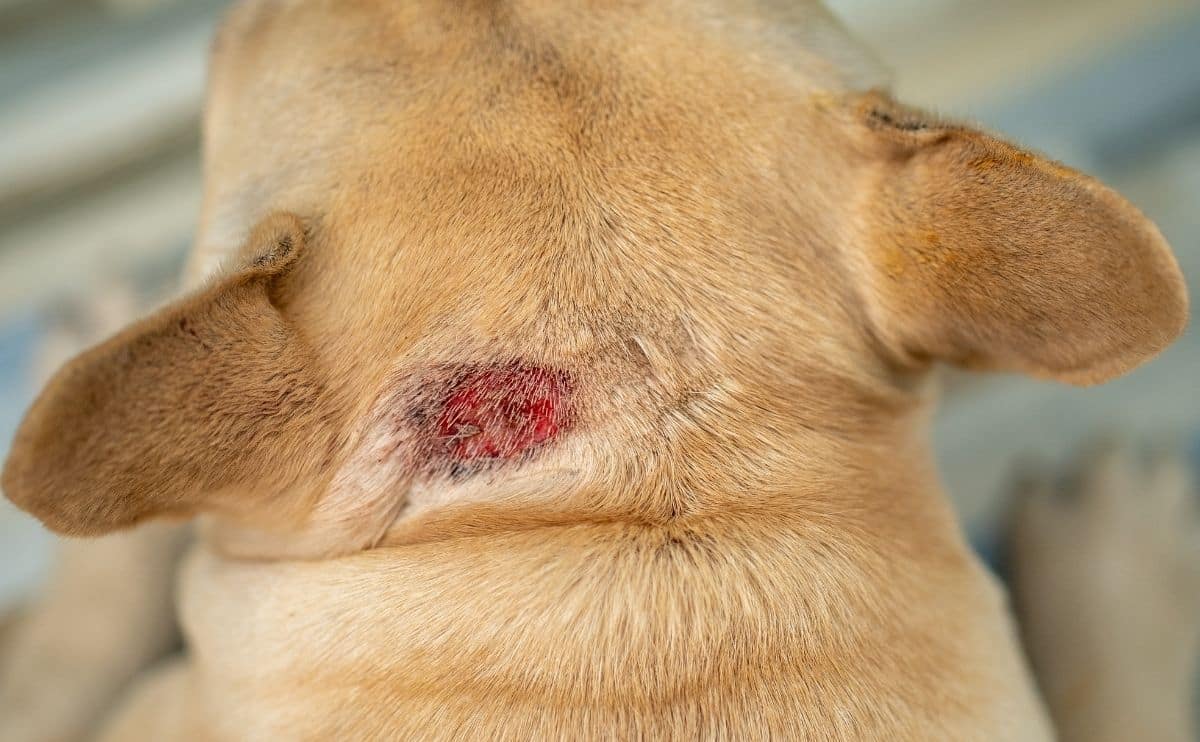The Spider In Your Basement Could Kill Your Dog—Here’s What To Know
When you purchase through links on our site, we may earn a commission. Here’s how it works.
Your dog’s been licking that red bump for hours. It wasn’t there this morning. You Google. You scroll. And then it hits you: “Could it be a spider bite?”
Table of Contents
Before panic sets in, here’s the truth: Some spider bites can cause nothing more than a mild itch.
Others? They can paralyze, rot tissue, or even kill. And you probably won’t see it coming.

Dogs & Spider Bites: When To Panic (And Head To The Vet Right Now)
This article contains everything you need to know about dogs and spider bites. But if you’re reading this because your dog is showing symptoms right now, don’t waste time scrolling.
If your dog:
- Becomes lethargic or collapses
- Can’t breathe properly
- Has black skin at the bite site
- Is trembling or paralyzed
- Vomits more than twice
Get to the vet. Don’t wait.
The Hidden Spiders In Your Home (That Actually Harm Dogs)
Not every spider scuttling across your floor is a threat—but a few can cause life-threatening damage in just one bite. And here’s the problem: most of us don’t know which is which.
While some spiders are harmless houseguests, others pack venom potent enough to paralyze your dog or rot tissue from the inside out. Before you write off that bump as a bug bite, meet the real villains hiding in your home.
The most common dangerous spiders in the U.S. for pets (and humans) are the black widow (Latrodectus species) and brown recluse (Lexosceles species). Far less common are red and brown widow spiders.
The venom delivered by a bite from these spiders can cause serious effects, which may require immediate veterinary attention.
Black Widow: The Silent Killer In Your Woodpile
It’s not just a spider. It’s one of the most venomous creatures your dog might encounter without warning.
Black widow spiders are found throughout the U.S., with higher concentrations in the South and West.
Adult females measure around 12–16 mm in body length (about the size of a small blueberry) and have long, spindly legs that bring their total size to nearly 38 mm. They’re shiny black with a vivid red or orange hourglass marking on the underside of the abdomen.
Males, in contrast, are smaller, often lighter in color, and don’t carry the same toxic load—only the females are dangerous.

These spiders aren’t aggressive and bite only when disturbed, usually while hiding in dark, quiet spots: sheds, woodpiles, basements, garages, and even under patio furniture or inside gardening gloves.
A bite from a black widow might not look like much at first—sometimes just a small red mark—but the venom can spread rapidly, especially in smaller dogs. Early symptoms can appear within 30 minutes, including:
- Muscle twitching
- Restlessness
- Yelping in pain without an obvious cause
According to the Merck Veterinary Manual, black widow spider venom is among the most potent toxins by volume. While dogs have some resistance, smaller and older dogs are more susceptible to severe reactions. Symptoms can include severe muscle cramping, tremors, and in extreme cases, respiratory distress.
Signs Of Black Widow Bites On Dogs
Female black widow venom contains α-Latrotoxin, a potent neurotoxin that affects the nervous system. Signs can present soon after the bite or take several hours to develop.
Small, young, old, and immunocompromised dogs are at the highest risk for extremely severe symptoms. If your dog is exhibiting these signs, seek vet care immediately.
- Abdominal pain
- Agitation
- Drooling
- Incoordination
- Increased heart rate and blood pressure
- Muscle pain and cramping
- Muscle rigidity
- Respiratory paralysis
- Tremors
- Vomiting and diarrhea
Black widow bites typically are much more toxic and life-threatening for cats versus dogs. If you have a cat exhibiting these symptoms, emergency vet care is crucial to saving your cat’s life.
Brown Recluse
Brown recluse spiders, also known as fiddleback or violin spiders, live throughout the central and southern U.S.
The adult brown recluse spider’s body is about 3-8 millimeters long with a leg span of around 24 millimeters. Males are usually smaller than females, but both males and females are toxic.
They are various shades of brown and have a violin-shaped marking on their upper abdomen.

Like black widows, brown recluses aren’t aggressive and like living in dark, undisturbed outdoor and indoor areas. But they’re more commonly found indoors than black widows.
The bite is typically painless at first. But within 2–6 hours, you might see:
- Blister that grows darker at the center
- Redness
- Swelling
In severe cases, the venom destroys tissue. This leads to deep, necrotic ulcers that may take weeks—or even surgery—to heal. Organs like the liver and kidneys can also be affected.
While data on brown recluse bites in dogs is limited, a study examining 149 human cases of brown recluse spider bites found that necrotic skin ulcers were present in 40% of cases.
Signs Of Brown Recluse Bites On Dogs
A brown recluse’s venom is hemotoxic, meaning it destroys red blood cells and causes tissue damage and tissue death (necrosis) around the bite site.
Symptoms of a brown recluse spider bite on a dog can vary widely based on the amount of venom delivered and each dog’s sensitivity to the venom. Most bites cause localized tissue damage, but rare cases can cause liver and kidney damage.
- A blister at the bite site that sometimes develops into a bullseye shape
- A severe, deep skin wound can develop over time
- Bleeding/bruising (abnormal clotting)
- Fever
- Lethargy
- Skin turning purple around the bite (necrosis, or tissue death)
- Vomiting
What About Hobo & Wolf Spiders?
Hobo and wolf spiders are common across many parts of the U.S., and while they look intimidating, their bites are usually harmless to pets.
Most dogs won’t react at all. Some might experience mild swelling, redness, or itching—similar to a mosquito bite.
The danger here is confusion. Wolf spiders are often mistaken for brown recluses because of their size and speed. But here’s the clue: if it’s fuzzy, it’s probably just a wolf spider.
Neither spider is aggressive. They bite only in self-defense, and their venom is not medically significant in dogs.
Still, if your dog has an allergic reaction—like hives or excessive licking—call your vet to be safe. Their bites might swell or itch, and in rare cases cause mild allergic reactions.
Not great. But not deadly.
Is This Just A Bite … Or A Medical Emergency?
Not all spider bites look scary—at least not at first.
Some are nothing more than a harmless bump. Others trigger allergic reactions or full-blown medical crises. This is where fast, informed judgment matters most.
Here’s how to tell the difference. Check the earlier sections on each spider for full symptoms related to Black Widow and Brown Recluse bites.
| Symptom | Mild Bite | Emergency Bite |
|---|---|---|
| Redness | ||
| Swelling beyond site | ||
| Necrotic skin | ||
| Vomiting | ||
| Lethargy | ||
| Muscle tremors | ||
| Breathing trouble |
Quick Tip: Use your phone flashlight to check hidden areas—under bedding, inside crates, and under decks—where spiders like to strike.
Signs Of Non-Toxic Spider Bites
It’s very difficult to distinguish most spider bites from insect bites unless you witnessed the culprit that caused the bite. Mild symptoms include:
- Small red bump
- Mild swelling and soreness
- Itching
- Licking the bite site
- Limping (if the bite is on the paw or leg)
Allergic Reactions
Allergic reactions to spider (and insect) bites can be mild, moderate, or severe. If your dog is experiencing these symptoms, you should call your vet. Breathing problems require immediate vet care.
- Hives
- Redness and swelling at the site
- Swollen face or muzzle
- Vomiting
- Difficulty breathing

Treatment for spider bites on dogs depends on the type of spider. It can be challenging for veterinarians to diagnose a spider bite.
The only certain diagnosis is if you catch the offending arachnid and bring it to your vet.
First Aid: What You Can Do Before The Vet
If your pup is experiencing discomfort from a non-toxic spider bite, insect bite, or bee sting without any concerning symptoms, you can treat the bite at home with the following home remedies.
Home Remedies For Non-Toxic Bites
- Wash the bite site with soap and water to help avoid infection.
- Apply a thick paste of baking soda and water or aloe vera gel to relieve itching.
- Use a cold compress for at least 10 minutes to reduce swelling and pain.
- Apply Sulfodene Dog Wound Care Ointment to help fight infection and relieve pain.
Symptoms should clear up in a few days, but keep an eye on your pup’s bite site. You should call your vet if it doesn’t clear up or symptoms worsen.
What Not To Do
- Don’t squeeze the bite: You may push venom deeper into tissue and worsen the reaction.
- Don’t apply hydrogen peroxide or rubbing alcohol: These irritants can damage healthy skin and delay healing.
- Don’t use essential oils or human creams: Many are toxic to dogs or ineffective for spider bites.
- Don’t wait more than 24 hours if it looks worse: Delays can turn a minor reaction into a full-blown emergency.
First Aid Kit Checklist
Keep these on hand so you’re not scrambling in an emergency.
- Chlorhexidine antiseptic wipes
- Cold packs
- Gauze and pet-safe wrap
- Tweezers
- Thermometer
How Do Vets Diagnose A Spider Bite?
Most spider bites happen when you’re not looking. Vets usually rely on your dog’s symptoms and history to rule out other causes.
There’s rarely a visible puncture mark. Diagnosis often comes from patterns—rapidly worsening wounds, muscle tremors, or vomiting paired with environmental clues like access to sheds or basements.
In severe cases, bloodwork may reveal signs of inflammation or muscle damage. Vets can take wound swabs or skin biopsies to rule out infections or autoimmune skin issues if needed.
But in most cases, it’s a clinical judgment call. Timing and symptom recognition are everything.
What The Vet Will Actually Do
For black widow bites, vets often use antivenom, muscle relaxants, and IV fluids. Brown recluse bites may need antibiotics, wound care, and sometimes surgery if tissue death spreads.
Costs vary widely depending on treatment length and severity. A mild bite might run $250–$600. But a serious case involving antivenom, surgery, or overnight care can easily exceed $2,000.
Treatment For Black Widow Bites
Fortunately, antivenom treatment is available to combat severe symptoms of black widow bites (for dogs and cats). Your vet may hospitalize your dog, and administer antivenom, which requires an IV fluid drip. This antivenom can have allergic side effects for some dogs, so your vet will monitor his reaction.
- Assessment: Vets first evaluate your dog’s vital signs—especially respiration, heart rate, and neuromuscular response.
- Antivenom: If symptoms are moderate to severe, your dog may receive antivenom (if available), though it’s typically reserved for severe cases.
- Supportive care: Muscle relaxants and pain medication help control spasms and discomfort. IV fluids may be used to maintain hydration and stabilize blood pressure.
- Monitoring: Dogs are typically monitored for 12–24 hours, sometimes longer, to catch any delayed reactions.
Most dogs have a good prognosis with prompt treatment, although full recovery can take a few months.
Treatment For Brown Recluse Bites
There is no antivenom for brown recluse bites, so treatment usually involves wound care.
Your vet will recommend regular wound care and may prescribe antibiotics to avoid infection. Most bites will heal within several weeks without complications, but your vet likely will want to check the wound site at least once a week to make sure it’s healing properly.
If your dog is experiencing severe systemic symptoms, IV fluids and hospitalization may be required (although this is rare). And if there’s been significant cell and tissue damage, your dog may need surgical treatment to remove the dead tissue and eventually skin grafting once the lesion stops spreading.
- Wound care: The vet will clean the wound and may remove dead tissue if necrosis has started.
- Antibiotics: These are often prescribed to prevent or treat secondary infections.
- Surgical intervention: In extreme cases, where deep ulcers form, surgery may be needed to remove damaged tissue and promote healing.
- Follow-up: Wounds are rechecked every few days. Healing can take several weeks depending on severity.
Stop The Next Bite Before It Starts
If you’re concerned about your dog or family being bitten by a toxic spider, try to spider-proof your home.
First, Make Your Home Less Inviting
- Vacuum dark corners and baseboards regularly
- Declutter closets, bins, and under-sink spaces
- Shake out towels, laundry, and pet bedding
- Store firewood well away from your home’s exterior
- Seal cracks around windows, baseboards, and doorframes
Where Spiders Hide—And How to Block Them Out
- Webs in corners, especially near floorboards or storage
- Small white egg sacs attached to fabric or cardboard
- Fast nighttime movement near windows or sinks
- One in the shower? That likely means a nearby nest
Spider-Proofing Checklist
- Install weatherstripping on all doors and windows
- Replace torn window screens
- Use sticky traps near walls, vents, and dark corners
- Spray a pet-friendly spider repellant in bedding zones
- Declutter under-sink areas
- Keep outdoor lights off when not needed (they attract spider prey!)
Real Talk: Pet Insurance Could Save You Thousands
Although toxic spider bites are relatively rare, many other costly health emergencies or illnesses can occur anytime with your dog.
You may consider getting pet insurance as a proactive measure to lower your financial risk related to unexpected health threats during your dog’s lifetime. Check out our comprehensive pet insurance guide to see if it’s a worthy investment for your family.
Frequently Asked Questions
You’re scrolling fast, and your dog’s acting weird. You don’t need a deep dive—you need quick, straight answers. Here’s a rapid-fire guide to the most common spider bite questions dog owners ask when panicking (or just trying to stay ahead of a scare).
Don’t see yours? Ask us in the comments!
Can A Spider Bite Kill My Dog?
Yes, especially if it’s left untreated from a black widow or brown recluse. Small dogs are more at risk due to their size and faster venom absorption.
What Does A Spider Bite On A Dog Look Like?
It may start as a red bump, often mistaken for a mosquito bite or pimple. Dangerous bites can develop into bruised, blistered, or necrotic skin within 12–48 hours.
How Soon Do Symptoms Appear After A Bite?
Mild bites may take several hours to show. But with black widow venom, symptoms like tremors or vomiting can show up in under 30 minutes.
What Should I Do Immediately After Spotting A Suspicious Bite?
Clean the area with soap and water, apply a cold compress, and prevent licking. Call your vet right away—don’t wait for symptoms to worsen.
Are Spider Bites Worse For Certain Breeds?
Smaller breeds, puppies, and senior dogs are more vulnerable to venom. Dogs with preexisting conditions may also have a harder time recovering.
How Can I Tell If It’s A Spider Bite And Not Something Else?
There’s often no puncture mark. But if it worsens fast, forms a bulls-eye, or causes full-body symptoms, assume it’s serious and seek vet care.
Can My Dog Be Allergic To A Spider Bite?
Absolutely. Just like bee stings, spider bites can trigger allergic reactions—especially in sensitive dogs. Signs include hives, facial swelling, and difficulty breathing.
Can A Spider Bite Be Confused With A Hot Spot Or Bee Sting?
Yes. They all start small and red, but spider bites may worsen rapidly and show systemic symptoms like vomiting or lethargy—hot spots don’t.
Are Spider Bites Contagious To Other Pets?
No. The venom isn’t contagious. However, other pets could get bitten if a spider hides in bedding or shared spaces.
Protect Your Pup
Looking for more ways to protect your pup? Check out our other guides at Canine Journal, including the best flea and tick prevention and first aid kit essentials.



